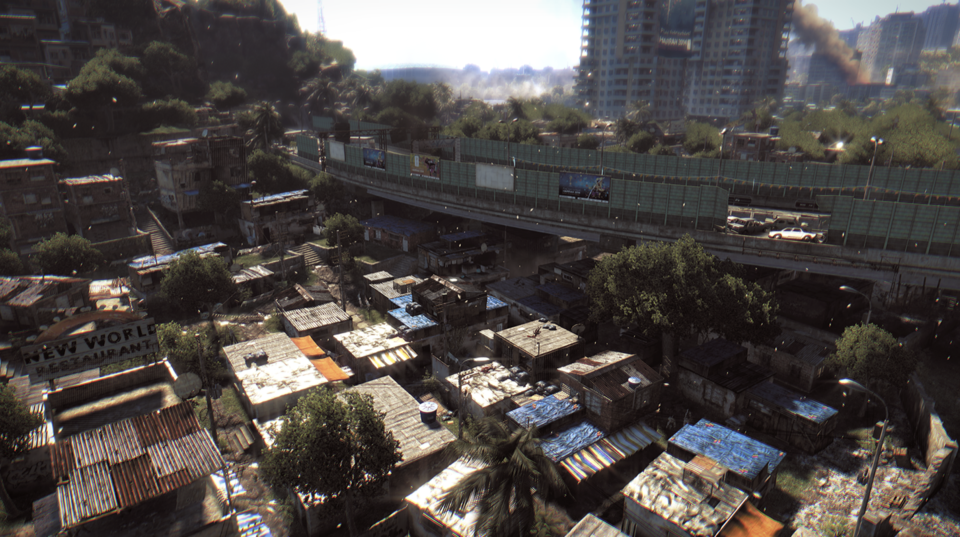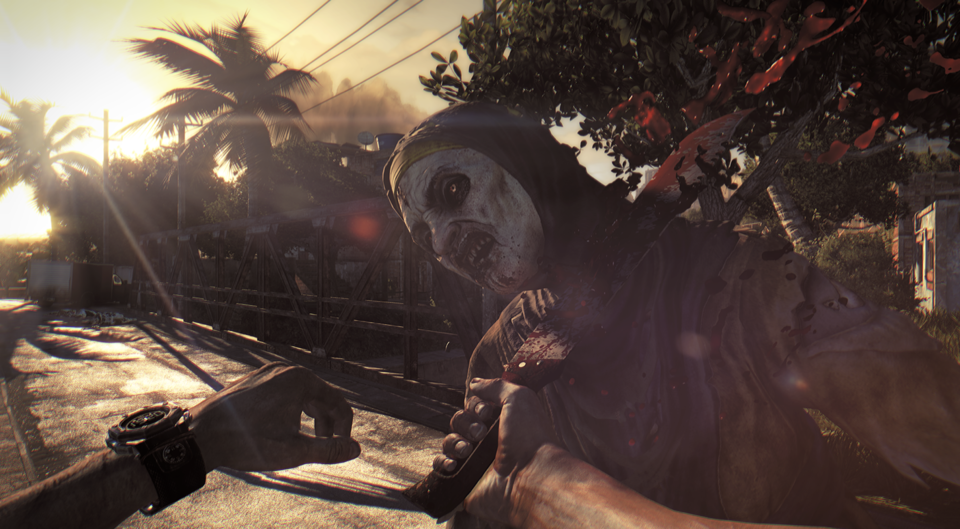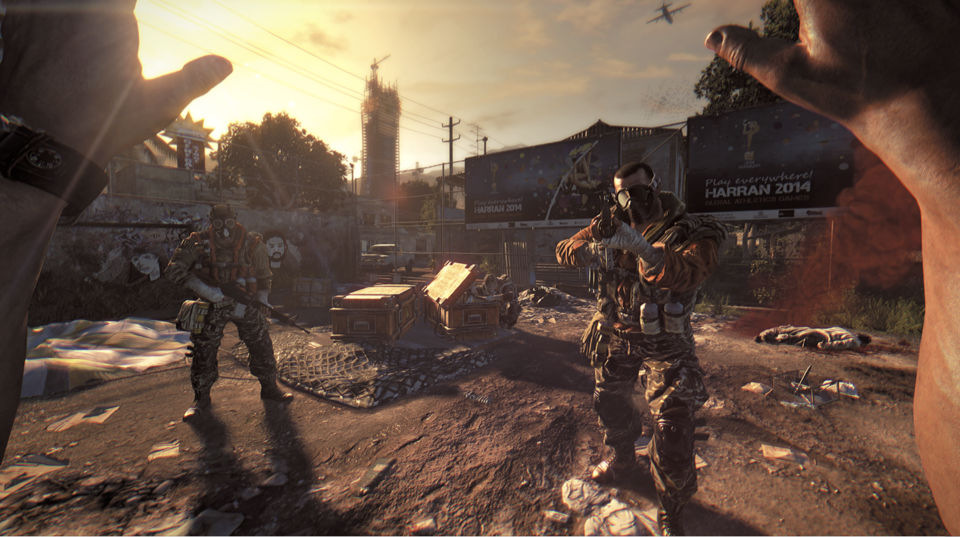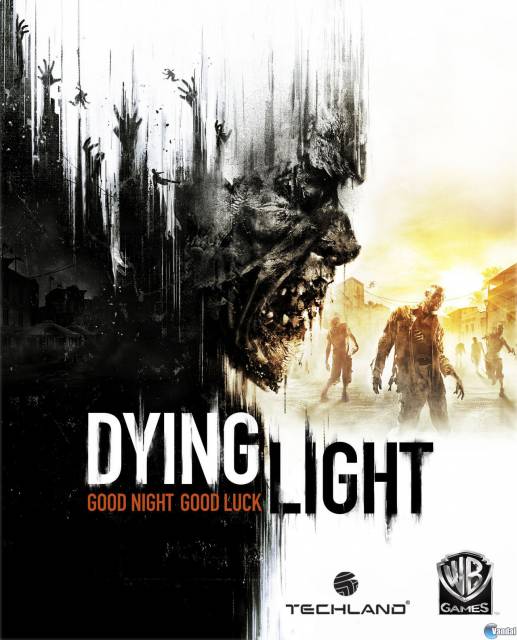As inconsistent as they come, there's still schlocky fun to be had here if you can stomach its issues
Standing on a rooftop in Harran is surprisingly serene. This fictional Turkish city is not your usual post-apocalyptic playground, after all. Beyond the burnt-out vehicles clogging up its highways and the bellowing black smoke ascending on the horizon, there’s beauty to be found as I gaze out upon its deserted streets from my elevated perch. The clear blue skies, glistening waters of its harbour and the orange hues a setting sun casts upon its ramshackle storefronts and cobbled together living quarters paint a picture of safety. Climb down from my perch, however, and the once distant groans beneath my feet build to a bloodthirsty crescendo of the walking dead, eager to feast on any notions of serenity. It’s easy to become overwhelmed once you’re on the ground, where the zombie population congregates in every nook and cranny of this once bustling city. So back up I scamper, onto the interconnected highways of Harran’s busy network of rooftops; where parkour rules the roost.

This emphasis on verticality is one of the few things that separates Dying Light from Techland’s previous zombie-kill-a-thon, Dead Island. While that game’s technical shortcomings meshed with a tiresome formula to produce middling results, Dying Light proves to be a much more polished and enjoyable experience, albeit one that borrows heavily from an amalgamation of different sources. From Ubisoft’s bloated open-world template to Fallout 3and Mirror’s Edge, to name but a few, this derived approach is obvious in its execution but isn’t necessarily a bad thing. Techland has done a good job of carefully plucking elements that smartly fit a focus on parkour and exploration. It may not always be consistent – and it struggles to find its own identity as a result – but I’ll get to that later.
Dying Light’s strengths begin and end with the way you traverse this quarantined city and how it incentivizes you to do so. The comparison to Mirror’s Edge is perhaps a little unfair – it’s nigh on impossible to pull off first-person parkour without earning comparison’s to DICE’s stylish freerunner – and the differences between the two couldn’t be more contrasting. Dying Light’s parkour is almost clunky – a little rough around the edges – but this is actually a good thing. It’s a design choice that seems intentional, presenting a system that’s more active and grounded in reality, where fallibility is an actuality. You have to look at ledges you want to grab onto otherwise you’ll miss, and surveying the environment and being mindful of your footing take on added importance, too. You’re not just effortlessly gliding from roof to roof or up the side of scaffolding like you would in something like Assassin’s Creed. It puts the onus on the player to not screw up, and it’s refreshing to know that it’s not simply holding your hand the entire time.
This is important, because allowing for mistakes in the middle of a zombie infestation should be a key ingredient to any game with such subject matter. Lose your footing or underestimate a gap between jumps and you could find yourself falling into the middle of a horde of living corpses. This is especially dangerous early on when Dying Light is at its best. With your skill trees yet to spread their branches and weapons that consist of ineffective table legs and simple baseball bats, your chances of fighting off a group of infected are slim-to-none. Even one-on-one it’s an arduous process, so you quickly learn to choose flight over fight, utilizing firecrackers and other distraction devices when you need to lure the undead away and descend from up high.
Emphasizing an avoidance of combat is smart since Dying Light’s melee-action isn’t particularly exciting, even when you get better at bashing the shambling dullards over the head. If you’ve ever played Dead Island before the combat will feel instantly familiar here, albeit with a disappointing lack of analogue control and viable limb targeting – a step back, if you will. You can still hack off limbs but it never feels like a particularly useful option (as it did in Dead Island with the big, grabby bastards, for example), so each enemy is tackled in very much the same way: with brutal blows to the head. This is fun for a time, but with too much exposure it’s a formula that grows stale fairly quickly. It’s never particularly bad, there just isn’t a lot to it. Your arsenal of melee attacks will continue to grow as you play, but the sense of combat progression is never profound, with a lot of it feeling superfluous. There’s no real advantage to dropkicking a zombie in the face other than the fact it’s rather humorous to see them go flailing backwards. You may be able to kick them into one of the spike traps placed around the city but there’s no real reason to when hacking at heads will solve any problem.

This is why Dying Light’s early hours are so effective. There’s a sense of helplessness early on, where combat is infrequent and running away is the best course of action. But that feeling of vulnerability is gradually lost as your weapon damage increases from 50 to 400 and each conflict becomes mindlessly trivial; only exacerbated by missions that task you with defeating waves upon waves of enemies to progress. The early stages feel unique in a way Zombie U did, where simply surviving and picking your moments to attack or flee are the focus. When it resorts to gallons of blood and an electrified katana, it lacks an identity and puts the focus on combat that strains under the pressure without its freerunning comrade.
Of course, this all changes once the dying light finally fizzles out and the dark of night takes hold of Harran. This is when a unique brand of incredibly fast and dangerous infected emerge from their daytime hibernation, transforming Dying Light into a tense stealth game. As you creep through the pitch black darkness (and I mean that literally, you can’t see anything without a flashlight) you’ll want to avoid the vision cones of these nasty buggers. If they do happen to spot you, then the chase is on. They’re faster than you are so you have these moments where you’re frantically looking left and right, trying to find something to climb up; the night time superbly emphasising the significance of Dying Light’s parkour. With the press of a button you can also look behind you to see an ever increasing horde hot on your heels, which is generally quite terrifying. I can’t recall another zombie game that has elicited thrills such as these. There’s even a risk/reward aspect at play, too. While the night may be substantially more dangerous, it doubles the amount of XP you can earn, forcing you to choose between staying out with its deadliest creatures or hunkering down for the night in one of the many safe houses dotted around the city.
And despite my grievances with the combat progression, the levelling system is actually rather excellent. You essentially earn XP as you perform certain things, be it climbing, fighting or completing missions, with a separate skill tree for each. With the parkour you’ll feel this gradual advancement as you not only begin to move faster and jump higher, but start incorporating rolls, slides and a grappling hook into your freerunning arsenal. You’ll need it, too, because without a fast travel option you’re going to be spending a lot of time traversing from one side of Harran to the next.
I wish I could say the missions are fantastic once you get there but, well… they’re not. In a lot of ways Dying Lightactually escapes the dreaded open-world fatigue with a map that’s refreshingly spacious, thankfully refraining from stuffing every inch of its frame with markers for nebulous mediocrity. The ones that are here are, however, fairly boilerplate, usually consisting of simple fetch quests given to you by the many denizens of Harran. They’re certainly more considered than those you might expect to find in a game like this, often having you visit multiple locations in one fell swoop – like going from a bunch of drug stores to a pizza restaurant – but you’ll still just be picking stuff up once you get there. I can’t begrudge this mission design too much because of the exploration it creates, especially since there’s something cathartic about raiding apartments and shops for the supplies you need to craft weapons and items. I just wish they had more interesting tales to tell beyond “go there and do this”.

The plight of Harran seems like the perfect setting for telling self-contained stories about these survivors and how they’ve built up a society within the confines of an overrun city, but Dying Light never goes that far. The core narrative is naff, of course, full of predictable clichés, terrible character development and plenty of unearned attempts at tugging on those heartstrings. You play as generic white man Kyle Crane, an agent for “the man”. It takes barely an hour before he’s conflicted about all the evil things he’s being told to do but then does anyway, before eventually deciding he’s had enough of doing evil things and decides to do good things instead. That’s about the extent of his arc. And there’s so, so much of it. Everyone wants to talk to you and they all babble on for absolutely ages. The text in the corner of the screen telling you what button to press if you want to skip a cutscene is perpetually tempting, you’re best just pressing it so you can get back to the good stuff.
Speaking of which, the two-to-four player co-op is as fun as you can imagine (if you’re imagining something like Far Cry 4), layering some competitive challenges on top to spruce things up between friends. There’s also an asymmetric multiplayer mode where one person can take control of a special infected to hunt down other players and zap around the city like Spider-Man, while the humans attempt to destroy its zombie nests to win. It’s a decent throw-away mode that you’ll probably try once and then never come back to again.
And there’s that inconsistency again. In a lot of ways Dying Light feels like the cobbled together weapons you so often craft; a game stitched together with the scavenged bits and pieces of its contemporaries. And like those weapons, as cumbersome and dull as it may sometimes be, there’s no denying the enjoyment its various pieces can occasionally conjure. It’s a shame those moments aren’t more frequent, though, because I really wanted to like Dying Light more than I did. I still wouldn’t hesitate to recommend it if you’re in need of some schlocky fun, there are just some caveats clutching on to this recommendation that even a bloody hatchet won’t fix.
